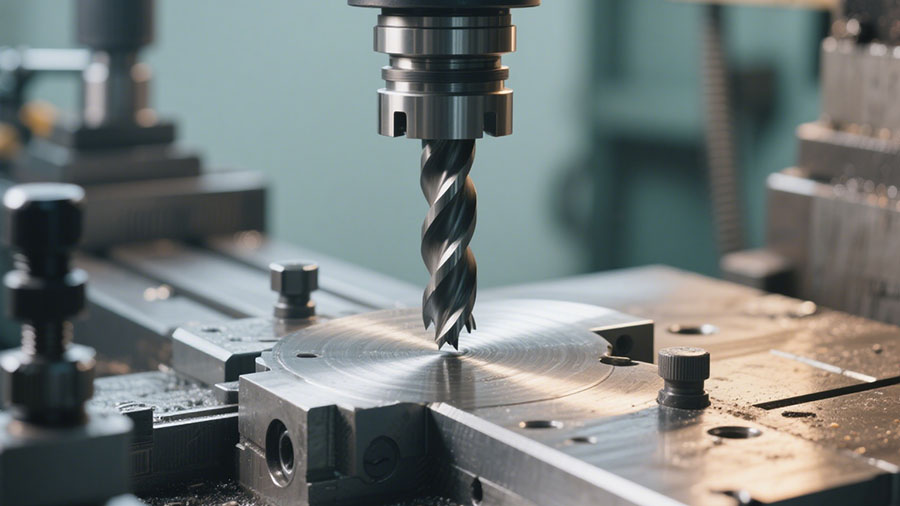In the field of precision machining, angle milling has become a powerful means of shaping complex parts with its unique process characteristics. It is a widely used technique in CNC machining and traditional milling operations, especially when manufacturing angled features, chamfers, bevels, or sloped surfaces. From key components of aerospace to fine components of electronic equipment, angle milling has been widely and deeply applied, providing a practical solution to the high-precision and high-efficiency requirements of modern manufacturing.
What Is Angle Milling?
Angle milling refers to the controlled removal of material from a surface using a milling cutter positioned at a specific angle relative to the workpiece, is also called angular milling. This is commonly achieved by adjusting the angle of the workpiece, tilting the milling head, or using specially designed fixtures and tooling.
Angle Milling: Breaking Through The Traditional Cutting Path
Angular milling is different from traditional milling. The plane produced by it is not parallel (or perpendicular) to the axis of the cutting tool, but at a specific angle to the axis of rotation of the tool. This unique processing method allows machinists to carve complex shapes that are difficult to achieve with traditional processes. When processing aircraft engine blades, the complex curved surfaces and angle features on the surface of the blades can be accurately presented with the help of angular milling to ensure the efficient operation of the engine.
The key to realizing angular milling is the deep integration of computer numerical control (CNC) technology. Through the CNC system, the movement sequence of the cutting tool and the workpiece is precisely programmed, and each action strictly follows the design blueprint. Whether it is a tiny electronic component or a large mechanical structure, it can be accurately processed under the control of CNC.

What Are The Types Of Angle Milling Cutters?
There are various types and sizes of angle milling cutters, which can be customized according to specific machining needs and applications. The following lists common types of angle milling cutters, but other specialized tools such as dovetail milling cutters and chamfer milling cutters can also be used for specific applications.
- Single angle milling cutter
Single angle milling cutters are used to machine single angle surfaces on workpieces. They have standard angles such as 30 °, 45 °, 60 °, and 90 °, and can also be customized according to specific requirements. These tools typically have cutting edges on the circumference and are used for chamfering, chamfering, and oblique groove machining.
- Double angle milling cutter
Double angle milling cutters have cutting edges on both sides of the circumference, allowing for the machining of two inclined surfaces in one operation without the need for tool change. They are used for processing V-shaped grooves, dovetail grooves, and chamfers, with both symmetrical and asymmetrical designs.
Methods Of Angle Milling
- Tilting the Milling Head
Most vertical milling machines allow the head to tilt left or right. Adjusting the spindle angle allows the cutter to engage the workpiece at the desired inclination.
- Using Angle Plates or Sine Plates
Workpieces can be mounted on adjustable angle plates or sine plates to hold them at specific angles during machining. This is ideal for precision angle cuts.
- Rotary Tables and Indexing Fixtures
Rotary tables provide angular positioning capabilities for complex geometries. These tools enable controlled rotation and positioning during multi-axis machining.
- Multi-Axis CNC Machining
Modern CNC machines with 4-axis or 5-axis capability allow for dynamic angle milling without physically repositioning the workpiece or spindle head. This approach enhances accuracy and reduces setup time.
Angle Milling Application: Precision Machining In Various Industries
In the field of aerospace, the high-precision requirements of parts make angular milling technology the key. The impellers of aircraft engines, structural parts of wings, etc., all need to be processed with precise angles and complex curved surfaces through angular milling to ensure the safe flight and high-efficiency performance of the aircraft. The impellers of aircraft engines need to rotate at high speed under high temperature and high pressure. The angular milling process can ensure the angular accuracy and surface quality of the impeller blades, thereby improving the combustion efficiency and power output of the engine.
In the automotive manufacturing industry, the processing of key components such as engine cylinders and transmission gears is also inseparable from the angular milling process. Through angular milling, precise hole systems, grooves and angle features can be processed on these components to improve the power performance and reliability of the car. The processing of various oil channels, water channels and mounting holes on the engine cylinder requires angular milling technology to ensure dimensional accuracy and position accuracy, thereby ensuring the normal operation of the engine.
In the field of mold manufacturing, angular milling technology helps to create various complex mold cavities and cores. Whether it is a plastic mold, a die-casting mold or a stamping mold, angle milling can process high-precision angles and curved surfaces according to the mold design requirements, providing guarantees for the molding of plastic products, metal castings, etc. The cavity of the plastic mold requires high-precision surface quality and complex shapes. The angle milling process can meet these requirements, so that the surface finish and dimensional accuracy of the plastic products can be effectively controlled.
Key Points Of Angle Milling Operation: The Key To Ensuring Processing Quality
When performing angle milling, it is crucial to reasonably select cutting parameters. The appropriate combination of cutting speed, feed rate and cutting depth can improve processing efficiency while ensuring processing quality. For different materials and tools, it is necessary to determine the best cutting parameters through experiments and experience accumulation. When processing aluminum alloy materials, due to the low hardness of aluminum alloy, the cutting speed can be appropriately increased to improve processing efficiency, when processing stainless steel materials, due to the poor cutting performance of stainless steel, it is necessary to reduce the cutting speed and increase the feed rate to ensure processing quality.
The correct installation and positioning of the tool is also the key to ensuring the accuracy of angle milling. When installing the tool, strictly follow the operating procedures to ensure the installation accuracy and stability of the tool. When using CNC machine tools for angle milling, the tool path also needs to be accurately programmed to avoid collisions between the tool and the workpiece or the machine tool. When processing workpieces with complex shapes, it is necessary to generate accurate tool paths through CAM software and perform simulated processing to ensure the safety and accuracy of the processing process.
The reasonable use of coolant can effectively reduce cutting temperature, extend tool life, and improve the quality of machining surface. When selecting coolant, choose the appropriate coolant type according to the characteristics of the processing material and tool, and ensure that the coolant supply is sufficient. When processing high-temperature alloy materials, special high-temperature alloy coolant is required to reduce cutting temperature and prevent tool wear.
Conclusion
Angle milling is a versatile and precise machining method used to produce angled surfaces and features across a wide range of industries. Whether you’re adjusting cylinder head geometry or crafting intricate aerospace components, mastering angle milling techniques ensures optimal functionality, fit, and finish. By leveraging the right equipment, tooling, and programming strategies, manufacturers can achieve consistent, high-quality results even in the most demanding angular applications.



